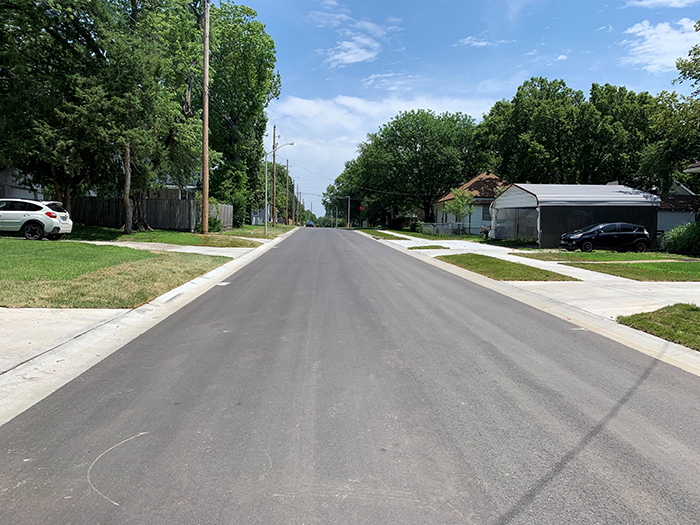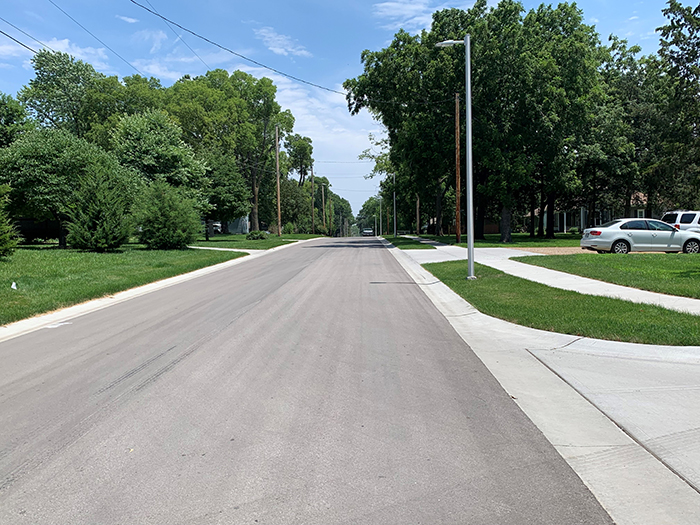City of Olathe Improves Aging Neighborhood with Full Reconstruction
Posted on Wednesday, September 1st, 2021 by Affinis CorpIn Roadway, Stormwater, tagged in

The City of Olathe, Kansas maintains the integrity of their infrastructure with an ongoing reconstruction program. They monitor pavement thickness to determine which roadways need to be paved and which should be reconstructed. When analyzing Cedar Street, between S. Parker and east of Walnut Street, they decided a full reconstruction was required and selected it for their 2020 project.
In addition, the established neighborhood’s sanitary sewer system was outdated. The city wanted to modernize it and bring it up to their standards by providing a single service line to each house. Prior to the reconstruction, the system was serving multiple homes from a single line.
We started our work on this project by analyzing the storm sewer. Based on our investigation, we found the area needed more inlets and increased pipe capacity to capture the current run-off. In response, 16 inlets were installed. We had to be strategic about placing them, balancing performance with the impact to residents. As a result, we avoided putting multiple inlets in front of a single home.
Cedar Street is a flat road in several locations, which made getting the slope necessary for drainage difficult. To improve the overall system, new pipes were integrated into it, while existing pipes were upsized. We needed enough depth to provide adequate cover over the pipes to ensure proper sod growth. As a result, we designed several runs of pipe at either a 0.7 or 0.8 percent slope, as opposed to a typical 1 percent. To support these improvements, a water line was relocated as well.
Along with the extensive stormwater and sanitary sewer improvements, we also reconstructed the aging street. We replaced the existing curb and gutter and updated streetlights and signage. Sidewalks and ADA ramps running the length of this section were also completely replaced, enhancing connectivity for pedestrians.

Coordination was key to the success of this project. Our team partnered with two engineering firms, city staff, and the railroad, integrating our design plans with theirs. One engineering firm was replacing a culvert under Cedar Street. The four-box system tied into Cedar Creek Crossing. To connect our designs with theirs, we had to work within the constraints of the elevations needed for the creek and the RCB. The second engineering firm was working in the west end, reconstructing Parker Street. Because this roadway connects with Cedar Street, we had to tie into their limits as well. We matched our reconstruction to theirs by using their CAD files, which provided the exact location and elevation.
Bridging the three projects together meant constant communication. We met regularly with the other engineering companies’ project managers, as well as the city’s project managers, for both projects. We also shared plans and provided one another with CAD drawings. Creating an open dialogue helped keep everyone on the same page.
We worked closely with the railroad to place the new sanitary sewer. Tracks split Cedar Street at the east end of the site. To complete the sanitary sewer system, we had to work outside of the project limits, boring under the rail line. This meant securing the necessary permits and coordinating closely with their team.
When constructing the project, phasing was critical to minimizing disruption to residents. The work was phased in two sections. The first half was west of the creek crossing, and the second half was east of the creek crossing. The four cell RCB construction took place during our project and required the road to be closed on either side of the creek. As a result, it made sense to phase our construction to be on either side of their closures, which also kept resident disturbance to a minimum rather than the entirety of the project.

The Cedar Street reconstruction program has increased not only the quality of the pavement and sidewalks, but also the sanitary sewer and stormwater systems for the area. By reinvesting in their infrastructure, the City of Olathe, Kanas continues to move their community forward. Improving quality of life for residents.